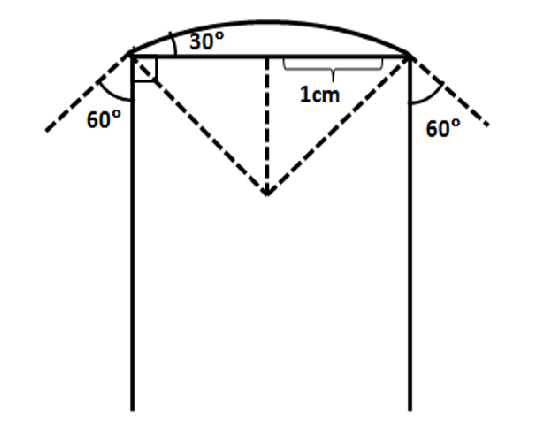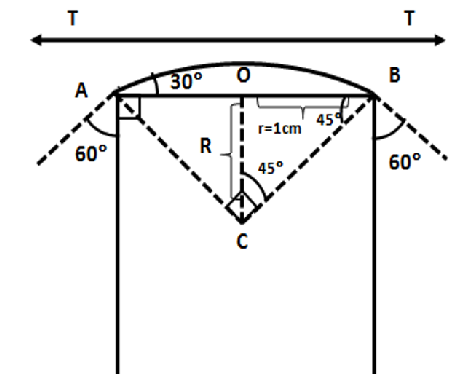
A soap bubble is being blown on a tube of radius\[1cm\]. The surface tension of the soap solution is \[0.05N/m\] and the bubble makes an angle of \[{60^ \circ }\]with the tube as shown. The excess of pressure over the atmospheric pressure in the tube is:

A. \[5Pa\]
B. \[1Pa\]
C. \[10Pa\]
D. \[20Pa\]

Answer
545.4k+ views
Hint:The bubble is making an angle of \[{60^ \circ }\]with the tube. Therefore, the bubble is bulged outside and appears to be convex upwards. There will be an atmospheric pressure on the bubble due to the weight of the air in the atmosphere. Also, there will be excess pressure acting downwards as a resultant of surface tension that can be calculated by the resultant force of surface tension.
Formula Used: The excess of pressure inside the tube is given as: \[p = \dfrac{{2T}}{R}\] where, \[T\] is the surface tension acting on the surface of the bubble
\[R\] is the resultant of the surface tension directed inside the bubble.
Complete step by step solution:
The surface tension acts along the free surface of the liquid. So, if the
The surface of liquid is convex upwards as shown in the diagram, the resultant of the surface tension acting along the tangent at the location of the molecule is directed into the liquid. Due to this inward force, the Pressure inside the liquid is higher than that outside it.
Therefore, the excess of pressure inside the soap bubble or in the tube is given as
\[p = \dfrac{{2T}}{R}\]\[ \to (1)\]
where, \[T\] is the surface tension acting on the surface of the bubble
\[R\]is the resultant of the surface tension directed inside the bubble.

It is given that the tube has a radius = \[r = 1cm = 0.01m\], and
the surface tension of the soap solution = \[T = 0.05N/m\]
Also, it is given in the diagram that the soap bubble makes an angle of \[{60^ \circ }\]with the vertical surface and \[{30^ \circ }\] with the horizontal surface of the tube. Drawing lines \[AC\] and \[BC\] such that \[\angle ACB = {90^ \circ }\]
Therefore, \[\angle OCB = {45^ \circ }\]
In \[\Delta OBC\], \[\operatorname{ta} {45^ \circ } = \dfrac{r}{R} \to R = \dfrac{r}{{\tan {{45}^ \circ
}}}\]
Substituting in equation (1)
\[p = \dfrac{{2T}}{{\left( {\dfrac{r}{{\tan {{45}^ \circ }}}} \right)}} = \dfrac{{2T}}{{\left( {\dfrac{r}{1}}
\right)}} = \dfrac{{2T}}{r}\]
Substituting the values
\[p = \dfrac{{2T}}{r} = \dfrac{{2 \times 0.05}}{{0.01}} = 10Pa\]
Thus, the excess of pressure over the atmospheric pressure in the tube is \[5Pa\].
Hence, option (A) is the correct answer.
Note: The excess pressure depends on the shape of the liquid surface and the resultant of surface tension. In case of liquid surface that is convex upwards, the pressure inside the liquid is higher than outside it (assuming that the pressure outside the liquid is atmospheric pressure). And, in case of liquid surface that is concave upwards, the pressure inside the liquid is less than outside.
Formula Used: The excess of pressure inside the tube is given as: \[p = \dfrac{{2T}}{R}\] where, \[T\] is the surface tension acting on the surface of the bubble
\[R\] is the resultant of the surface tension directed inside the bubble.
Complete step by step solution:
The surface tension acts along the free surface of the liquid. So, if the
The surface of liquid is convex upwards as shown in the diagram, the resultant of the surface tension acting along the tangent at the location of the molecule is directed into the liquid. Due to this inward force, the Pressure inside the liquid is higher than that outside it.
Therefore, the excess of pressure inside the soap bubble or in the tube is given as
\[p = \dfrac{{2T}}{R}\]\[ \to (1)\]
where, \[T\] is the surface tension acting on the surface of the bubble
\[R\]is the resultant of the surface tension directed inside the bubble.

It is given that the tube has a radius = \[r = 1cm = 0.01m\], and
the surface tension of the soap solution = \[T = 0.05N/m\]
Also, it is given in the diagram that the soap bubble makes an angle of \[{60^ \circ }\]with the vertical surface and \[{30^ \circ }\] with the horizontal surface of the tube. Drawing lines \[AC\] and \[BC\] such that \[\angle ACB = {90^ \circ }\]
Therefore, \[\angle OCB = {45^ \circ }\]
In \[\Delta OBC\], \[\operatorname{ta} {45^ \circ } = \dfrac{r}{R} \to R = \dfrac{r}{{\tan {{45}^ \circ
}}}\]
Substituting in equation (1)
\[p = \dfrac{{2T}}{{\left( {\dfrac{r}{{\tan {{45}^ \circ }}}} \right)}} = \dfrac{{2T}}{{\left( {\dfrac{r}{1}}
\right)}} = \dfrac{{2T}}{r}\]
Substituting the values
\[p = \dfrac{{2T}}{r} = \dfrac{{2 \times 0.05}}{{0.01}} = 10Pa\]
Thus, the excess of pressure over the atmospheric pressure in the tube is \[5Pa\].
Hence, option (A) is the correct answer.
Note: The excess pressure depends on the shape of the liquid surface and the resultant of surface tension. In case of liquid surface that is convex upwards, the pressure inside the liquid is higher than outside it (assuming that the pressure outside the liquid is atmospheric pressure). And, in case of liquid surface that is concave upwards, the pressure inside the liquid is less than outside.
Recently Updated Pages
Master Class 11 Economics: Engaging Questions & Answers for Success

Master Class 11 English: Engaging Questions & Answers for Success

Master Class 11 Social Science: Engaging Questions & Answers for Success

Master Class 11 Biology: Engaging Questions & Answers for Success

Class 11 Question and Answer - Your Ultimate Solutions Guide

Master Class 11 Business Studies: Engaging Questions & Answers for Success

Trending doubts
10 examples of friction in our daily life

One Metric ton is equal to kg A 10000 B 1000 C 100 class 11 physics CBSE

Difference Between Prokaryotic Cells and Eukaryotic Cells

1 Quintal is equal to a 110 kg b 10 kg c 100kg d 1000 class 11 physics CBSE

Explain zero factorial class 11 maths CBSE

What is a periderm How does periderm formation take class 11 biology CBSE




